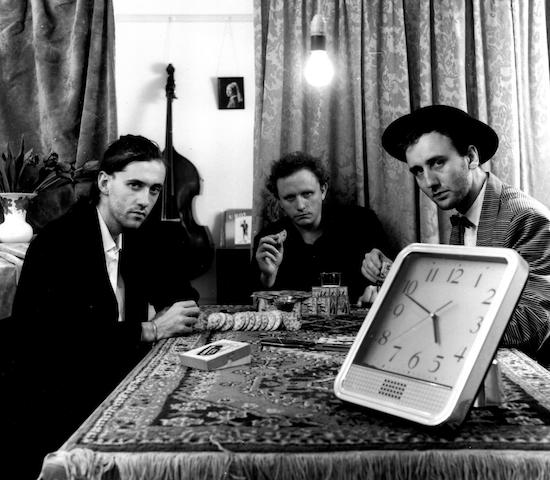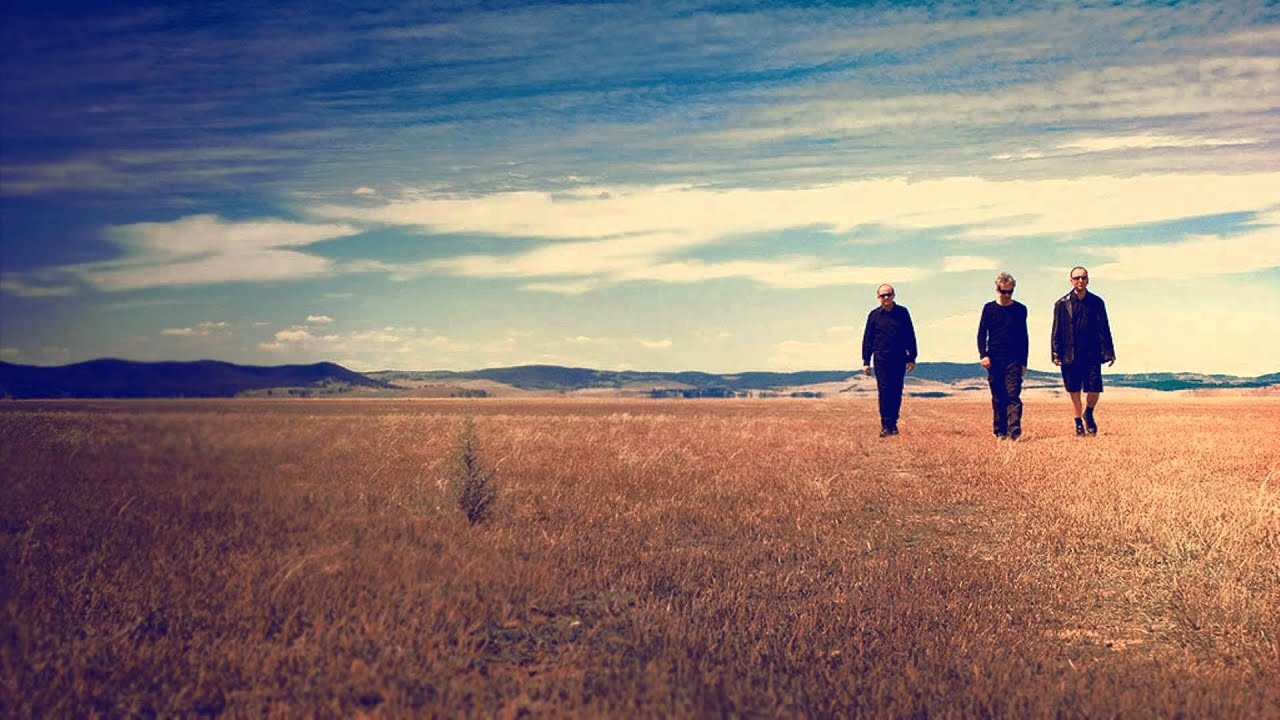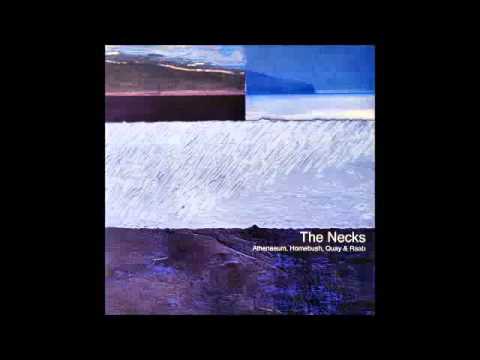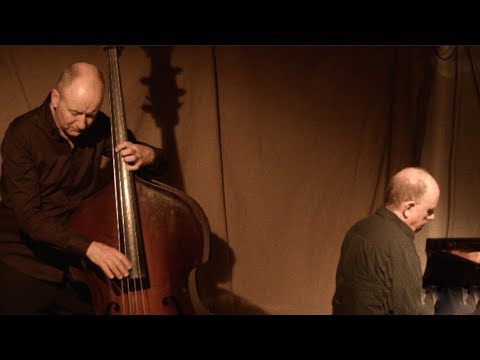Portrait by Anne Zahalka
The Necks are an Australian improvising jazz trio formed in 1987 by Chris Abrahams who plays piano and Hammond organ, the drummer and guitarist Tony Buck and Lloyd Swanton who plays bass. They recently celebrated their 30th anniversary and show no signs of slowing down. They set off on another European tour this week.
Hanging Gardens (1999)
Though 1989 debut Sex represents The Necks’ most widely acknowledged release, we will instead begin with their sixth album, Hanging Gardens, which in many ways feels like the perfect starting point.
Tony Buck: One motivation for many of our albums is simply a desire to “do something different” from our previous releases. This is a simplification of many of the motivations that drive the creative forces that steer a recording, but it has to be said that it is often a reference when heading into the studio to commence a new project. The previous studio recording featured the track ‘Black’ from the Silent Night release, and I think it’s fair to say that ‘Black’ is particularly minimal, even by our standards, and also very slow. Speaking from a personal perspective, I think I was fairly taken by the things I was hearing coming out of the drum & bass world, as well as artists such as Squarepusher and Photek, for example. It seemed a way to explore some of these influences, possibly seen through the lens of a post-70s Miles Davis type thing… fast, intricate but a little rough around the edges. As a gateway album I guess it could serve quite well in that the material we play with is fairly accessible, although the pace and density of the record isn’t exactly representative of too many other of our releases I’d have to say.
Lloyd Swanton: I can’t add much to what Tony has said here, and I agree with every word of it. I think Hanging Gardens stands out in our body of work for its brisk energy, and perhaps to some ears that means “accessible” more than other characteristics might do. It’s also my recollection that we worked on this album on and off over quite an extended period of time. Not sure whether that is a factor in giving it its unique quality. From memory we did one complete mix and mulled on it for several months but concluded it was too dense too soon, and so we went back into the studio and sculpted it so it would unfold far more gradually.
Drive By (2003)
A couple of albums later, ‘Drive By’ served up a totally different sonic palette. Anchored by a relentlessly addictive drum and bass groove, it is peppered by found sounds including the likes of what appears to be a swarm of bees, frolicking children, a passing helicopter and even a monkey. In this way, ‘Drive By’ seems to be The Necks’ most narrative-driven piece.
LS: My recollection was that we had a plan to record two complete versions of the ensemble, playing contrasting grooves that worked in polyrhythm to each other, which we would then crossfade in and out. We got a little distracted along the way, which to me is one of the delights of making music with The Necks. We don’t ever want to get bogged down in dogma. So although you can clearly hear how some elements of that plan remain, in the metric shifts from 3 to 4 and back, we ended up following all sorts of tantalising threads, and in the end didn’t really get very polyrhythmic per se. Interestingly, speaking to fans, Drive By often comes up as the one they find most similar to Sex. I don’t hear it, but perhaps I don’t have their objectivity.
TB: Drive By followed Aether, probably one of our most ethereal and sparse albums. I seem to recall references as varied as Conlon Nancarrow and trip hop being bandied about in the sessions. Both Chris [Abrahams – piano] and I have both contributed some samples and electronics over the years to studio recordings, and from memory there was a lot of material like this that Chris had at hand. I think we felt it a way to introduce a certain kind of atmosphere, more than anything. The track that I would credit as having the most overt sense of covert narrative however would be, again, ‘Black’ [from Silent Night], where we did layer samples in a way to suggest some kind of unfolding.
Aether (2001)
Aether is perhaps The Necks’ most uncanny work and almost unrecognisable as that of what is generally an acoustic musical trio in its alien beauty.
LS: It’s a personal favourite of mine, and a clear reminder of how gratifying it can be to set out recording an album with next to nothing in mind, but by following our instincts and by putting things up for consideration and by using our imagination, something quite unforeseen takes shape.
TB: I agree that this is one of our most mysterious and beautiful records. Again, I feel it was influenced quite considerably by its predecessor, Hanging Gardens, in terms of massive contrast, as I’ve talked about. From my perspective I remember being interested in exploring some of the quite minimal and spacious sounds that I was dealing with in the Berlin improvised music scene at the time; the use of space and silence and a quiet coalescing of sound. I remember we had the idea to slowly introduce a specific cycle of sounds/textures and very slowly let them merge into a very slow pattern over a long time. We actually used two different tempo click tracks to layer pulses with different rates and characters and then see what we would end up with in the mix. There were some interesting things done in the studio with the sounds, from a technical perspective, but to talk about that aspect of this recording serves no real purpose to me than to dilute and slightly demystify the record, which I’d rather not get into!
LS: Sorry Tony, I’m happy to demystify, if only because I feel, in describing a few of the choices we made, it only serves to intensify the question “but what on earth made us even think of that?”, which I feel none of us can answer, thus perpetuating the mystery. For me, three things give it its unique quality. The first is Chris’s decision to use a sampled piano sound with the front of the note shaved off, to the extent that it starts to sound a little more like a guitar. The second is the roll-off into pitch-black silence that we programmed onto the end of every phrase in the opening two thirds of the piece. I get this very physical feeling of falling down a mineshaft, yet somehow being effortlessly brought back to the surface only to tumble into blackness again. And then there is the incredible “hailstorm” in the final third, generated by Chris and Tony laying down multiple pounding 16th-note tracks that, coupled with Chris’s stuttering Hammond organ, give the piece such a striking, shimmering climax; so physical. Chris’ and Tony’s sustained stamina in that sort of situation has to be seen to be believed. I was incredibly proud when Aether was inducted into the Australian National Film and Sound Archive’s The Sounds of Australia – their ongoing “hall of fame” of significant Australian sound recordings.
Athenaeum, Homebush, Quay & Raab (2002)
A four-disc live compilation which is now out of print but perfectly captures the most important entry point to the music of The Necks: live performance.
TB: Firstly, we have a great number of live recordings. Way too many to go through with any focus in any realistic way when thinking about releasing a live recording. While some concerts seem quite special and are, in a casual way, earmarked for possible release, most are filed away to perhaps be looked into at some further date. It’s also interesting that what might seem like a particularly successful concert might not always translate to the recorded medium quite so well. There are a lot of variables at play. One big one is that so often the way the sound moves around the room contributes so much to the overall sense of the event. This is almost always impossible to capture in a recording.
LS: Recording our live performances brings up a whole raft of issues. When someone is listening to one of our improvisations unfolding in concert, they have in common with us the fact that it is impossible to fully keep track of what has happened so far, and when it happened. I think one of our most attractive attributes is that we can finish a live piece and everyone in the room, us included, can be asking themselves, “How on earth did we end up there?” No one, no matter how musically savvy, can instantly recall the sequence of events of a one-hour piece of music. But by freezing a piece of music in time, we are able to repeatedly listen to it and thus get more and more acquainted with sections of it that may have already disappeared from our memory by the end of the live performance. And with that comes a greater expectation of structural development. Many of our pieces may appear really great on an initial listen, but after getting really acquainted with them over several listens, we might start to think, “You know – two thirds of that one is great but I don’t think where it eventually goes to is so wonderful” or “That one gets into such a wonderful area but it takes so long to get there”, or countless variations of that sort of thing. So we can all become hypercritical. As we should, because we’re doing something quite perverse with these spontaneous performances – we’re freezing them in time and offering people the freedom to play them over and over again.
TB: Recording a concert has so many compromising aspects. I feel we are very lucky, quite frankly, if we manage to capture a half decent concert on record. That said, while the studio recordings are approached very differently and with a contrasting attention to detail, in lots of ways, I do feel like we are trying to use both vehicles, with their inherent positives and negatives, to somehow express similar musical endeavours and aesthetics in lots of ways.
LS: I think we have unusually high standards for our live releases, which may partly explain why we have hundreds of hours of recording but have only released a handful of them. Plus, just in a practical sense, with our pieces being so long, curating our live recordings is a huge task. There just isn’t time in the day to listen to everything we’ve recorded. (I can envisage that when we finally hang up our boots, we’ll employ a room full of interns, each with a bullet point sheet of parameters, to work through our output!) The only way to even begin to decide whether or not a piece is worthy of release is for all three of us to live with it for weeks on end, doing that intense familiarisation process I described above. We insist on unanimous approval in all aspects of the band’s activities (I think that’s one reason why we’ve lasted so long – we’ve said no to so many things along the way!), so if differences of opinion appear within the band to do with a particular piece, well that’s one more piece that’s never going to see the light of day!
Memorable Live Experiences
TB: I always think of our Berlin concert at Berghain during the Märzmusik festival in 2014. This gig was memorable for me for a number of reasons. It was in Berlin, where I live, and so I had the opportunity to bring some larger, travel-unfriendly instruments with me to the concert, like the large monochord instruments was had just used on the album Open, for example. It was the first time I had the impression that the audience in Berlin had taken on a kind of ‘home team’ sort of feeling, and that was hugely satisfying after performing in the city so often. The other major factor was the incredible sound of the room and the PA, which is usually used in the context of decibel-heavy techno most of the time. This Function One sound system is renowned to be one of the best PA systems in Europe and it was amazing to hear how the PA dealt with the subtlety and clarity of our sound so well. It was one of those sounds that made the hair stand up on the back of my neck for days afterwards. A most memorable concert.
LS: Yep, that was quite a gig.
TB: Thinking about this concert, and the circumstances of the room and the PA, makes me reflect on the way in which the band plays and projects into a room, and uses the resulting resonances in ways that also shape and influence the music as it unfolds. It is interesting that while we are very concerned with the interaction of the three acoustic instruments when we play concerts, the way in which we have come to utilise a PA and microphones as a tool to enhance and amplify the culminating resonant sound is very important.
I have the impression there is a misapprehension among some promoters that if we can present our music purely acoustically, or in some “special” venue or space not used for music making in general, that they will somehow get some more authentic representation of what we do. While there have been a few occasions where we have indeed found ourselves in an exceptional acoustic space it is indeed, quite rare. A venue that has been set-up for music performance, with good production facilities, sound system, acoustics and audience space is by far more productive, I find, for our purposes. We have, over the years, become quite used to enhancing our dynamic and timbral range and possibilities by taking advantage of how miking our instruments well can bring to the acoustic properties of those instruments and how they interact.
How about a memorable tour?
LS: For me it’s been the “firsts”. Our first tour of Europe in 1998, and our first tour of North American in 2009, because in both cases we were by no means certain that the audiences on those territories would “get” us, and yet they did, most emphatically. Also, our very first tour, where we were ‘The Necks’ in name only, touring Mexico in 1987 as the accompanying trio for a great Australian singer called Jeannie Lewis. She is a very diverse performer, so we were playing a set which included Latin American leftist protest songs, blues, Edith Piaf, improvisation, and contemporary Australian pop. Added to all the mandatory chaos of touring in the developing world, we had a documentary crew along with us, with mountains of equipment and a director who was, let’s just say, temperamentally unsuited to the idiosyncrasies of touring and making a doc in the developing world.
Mosquito / See Through (2004)
LS: From memory, in regards to us releasing ‘See Through’ after ‘Aether’, I suggested to the fellas that we continue the use of silence, only this time extending the silences considerably. The guys liked the idea, but I quickly found that whereas I’d been thinking “extending” meant maybe 20 or 30 seconds, they were talking 2 or 3 or 4 minutes. I was happy to run with that though, and I think it’s a really special piece in the way the silences are so huge that any ambient sounds in one’s listening room become part of the work. Also that the silences are so extended that no-one can correctly predict where the ensemble is going to re-enter, so those re-entries have an impact far beyond the actual motif involved.
TB: Speaking personally, both these records to me represent a specific way of playing and dealing with material that was, at the time, quite new for the group. For me, a very specific recording by French clarinet player Xavier Charles was an inspiration for trying to find a way to use stretches of silence or near silence within a larger scale piece like we attempted in ‘See Through’. Similarly, speaking personally, I wanted to try and play a pointillist, ever-changing type of material, but somehow find a way to bring out unusual cycles, minimal repetitions and pulses not normally associated with that type of playing – exploring where single events, played in a certain way, cross the threshold and become a unified texture. In a way, it was through that recording process that I came to realise that it is not really the type of material we draw on in The Necks, but the way in which we deal with the material. I like the way ‘Mosquito’ tends to put musical elements that might normally be found in the background in the foreground, and vice versa. I can see why the feeling of Feldman might come to mind in Aether for example. Not so much with these two records.
LS: For me, the big influence for the non-silent passages on ‘See Through’ is Alice Coltrane’s post-John Coltrane work. In answer to your question about what musicians we hold in high regard, I would definitely say Alice Coltrane. John Coltrane too, for his journeys into ecstatic music, and his investigations of non-Western idioms. Charlie Haden’s focus on the beauty of one note is philosophically a big driver for me, and also, his sustained octave thrumming technique as a means of maintaining forward rhythmic propulsion without any harmonic movement was something that I feel I have tried to let inform my whole concept of my role as bassist in The Necks. I try to provide something which offers possibilities and stimulation, but can also be taken as simply more of the same. But, other than those specific examples, what has inspired me for The Necks mostly has not been individual musicians, rather whole style or traditions, like funk, dub reggae, all manner of hypnotic African music, and gamelan and other Indonesian traditions.
Open (2013)
Open is the longest single track studio recording officially released by The Necks.
TB: I think it’s important to point out that, for our studio recordings, we don’t go in and improvise a piece of music as such, then work on it in post-production a little. (The album Sex was a little like this as we did have an hour long template over which we added parts). Most albums only really come into being, as a finished piece, in the mixing process. I guess when we mix and find satisfactory ‘scenes’ and ‘transitions’ and some kind of satisfactory ‘narrative’, then the piece is finished. In theory there could be any number of different pieces of music coming out of the sessions that become the one released. Again, with Open, it was a little bit the case of wanting to contrast the previous, quite raucous elements of Mindset, in a sense. I seem to recall many of the decisions and elements that go to contribute to the feeling of Open happened in the mix. The use of the monochord instrument so prominently in the intro, which to my ears sets up the atmosphere the track builds upon, was a quite random decision I think. (I had originally recorded a few short performances playing it at home in Berlin and had them with me in the studio in Sydney. The original intent was probably more as a fleeting colour every now and then). I seem to remember we all felt we wanted to maintain a very transparent and open feeling to the record throughout, although it took some months for Chris to suggest the title Open, as we often spend longer debating and trying to come up wth titles than we do on the music!
LS: I can’t add much to what Tony has said, except to say that we really don’t have much in mind at all in respect of what kind of “story” we want to “tell”. Most times in the studio we just start out in a loose direction, and then listen back and discuss amongst ourselves what that suggests to us, and who among us has some ideas that would advance the piece. In terms of ending the piece, I guess it’s simply a calculus based on whether we feel we’ve included all that we want to include, in a timely fashion.
Collaborations with Ilan Volkov
The Tectonics Festival in Glasgow, 2017 marked The Necks’ second collaboration with Ilan Volkov, a composer and conductor through which they paired their music with the BBC Scottish Symphony Orchestra for a large scale improvisation.
LS: I am so proud of what we achieved with these two performances. Ilan’s unique approach and vision showed that it is possible for a symphony orchestra to improvise (in at least some definition of the verb) coherent, gratifying music. That’s no mean feat – just within an improvising three-piece, there are mathematically so many potential misunderstandings, so of course that can quickly become completely unmanageable if you’re granting individual agency to an entire symphony orchestra. It was only possible because Ilan is, uniquely, both a highly credentialed classical conductor (so the orchestra trusts and respects him), and an improviser himself, totally conversant and comfortable with the language. So he takes what we come up with and translates it into amazing orchestral textures. It really is quite incredible what he can get 60 or 80 highly disciplined orchestral players to generate, once they’ve overcome their almost pathological (but thoroughly understandable) fear of deviating from the written page. If there’s one thing orchestral musicians do stunningly well, it’s respond to direction, so, because they trust him implicitly, they will go wherever he takes them.
TB: I personally found the prospect of working with Ilan in the orchestral setting exciting and very promising. To me it was a chance to see if we could translate some of the textural and timbral ideas we often play with in the studio into a larger scale, in a live setting. While we haven’t used string sections or orchestral musicians before, I feel we do sometimes play with textures and ideas that could be translated using that kind of palate. Of course we had to compromise the idea that we simply go on and play with no preparation a little, but it was, at the end of the day, a very minimal compromise. The orchestra had an idea of some of the things we would imagine hearing with us while we did our thing. Ilan had their full attention; we walked out and played pretty much as we do and he improvised around those ideas and textures as he saw fit. In a very real sense it was The Necks improvising with another person, Ilan, and his instrument was the orchestra. Of course to be part of such a massive sound world as is generated by a symphony orchestra was an unusual situation for us and one that was exhilarating to say the least. We do however often find ourselves in strange acoustic settings and unusual contexts so in many ways this was just another one. I felt both concerts in Adelaide and Glasgow were really successful and, if it were possible, would love to have them as part of our release catalogue someday.
LS: The first time we did ‘Elemental’ (as we’ve titled the piece) with the Adelaide Symphony Orchestra felt, coupled with the exhilaration of the incredible music we made together, such a powerful feeling of relief that it had worked so well, because in all truth, we didn’t have a Plan B. It had to work. It’s a shame that the BBC video of the Glasgow concert is no longer up on their site, because, given that I have my back to the orchestra the whole performance, it was quite a revelation to me to see what was going on behind me as I played. Ilan’s physicality is electrifying. I’d also like to pay tribute to the management of the BBC Scottish Symphony Orchestra for the subtly subversive act of removing all the music stands from the stage before our performance – it’s such an incredibly different sight to see a whole orchestra performing without music stands.
Unfold (2017)
The Necks’ nineteenth and most recent record that perhaps acts as an possible entry point into the experience of watching the band play live.
TB: I feel like ‘Unfold’ would be a perfect entry point into the way the band is playing live a lot of the time nowadays – which is probably fairly obvious because it is more or less, live performance captured in a studio, recently, with little or no post-production. We did a similar thing with the track ‘White’, from the Silent Night release actually some 20 years ago!
LS: I would definitely say that Unfold differs from previous releases, with the exception of White, as cited by Tony, but I wouldn’t really call it a new chapter, as that could imply that our musical narrative is going to continue in that direction for at least a while. As Tony has mentioned several times in this interview, there is some sort of checkerboard pattern to our catalogue, insofar as one criterion for each release is to differ from at least the previous one, and I can say for sure that the new album we have partly finished is utterly different to Unfold. Although the pieces on Unfold are close to “live” recordings, I’m not entirely sure they function as an entry point because, being short so as each to fit on an LP side, they don’t really prepare the novice for the sheer enormity of our live pieces.
TB: I do find it intriguing that there is a sense sometimes that our studio recordings are totally improvised, although perhaps we should be flattered that people think we are technically capable of playing three or four pianos, two double basses, two drum kits, organs, guitars, various percussion instruments and a bunch of synths and samplers spontaneously and simultaneously in a studio. In light of this idea, I guess Unfold holds less mystery and intrigue, as it’s fairly clear what’s going on, which I suppose makes it a good entry point into the way the group is playing. Possibly, and hopefully, we will be exploring fresh and interesting new things soon enough, so perhaps it is, in a way, representing a new chapter – chapter 19 – in the as-yet unfinished larger work of many, many more chapters…
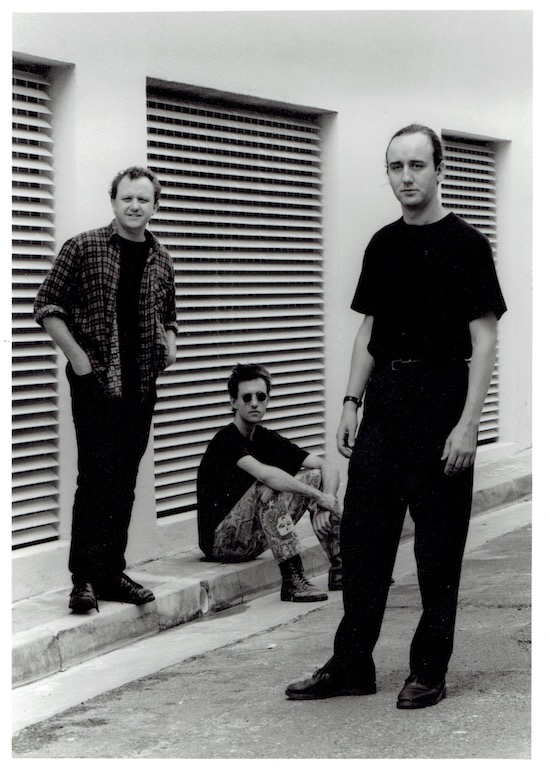
Portrait by Michelle Agius-Hall
Beyond The Necks
TB: I think there is an interesting thing about the way The Necks work. While it’s fair to say The Necks is the priority project of the three of us, it is also something that leaves room for lots of other projects and interactions with other musicians and ways of making music. Because of this, in a way, when we do get together to tour and record again as The Necks, we have all been involved in many other, quite different kinds of things. We all perform and record and release music with other people and with our own personal other projects. This all feeds, even quite subtly, back into The Necks in ways we are probably not even aware of.
Chris has released a number of albums of solo, more electro-acoustic music on the Room40 label in recent years in which, to me, and I might be very wrong here, he seems to explore timbral, sonant spaces that I can imagine him utilising in the context of The Necks but it sounds to me that he is investigating very different formal and structural approaches that bear little in common with the aesthetic of our group. Likewise I have recorded music that draws heavily on quite contrasting ways of making music, sometimes dealing with rock oriented forms, like my Transmit band or more abstract improvised settings, like my duo with Berlin based pianist Magda Mayas. I am about to release a solo recording – also on Room40 – called Unearth, that in lots of ways is quite close to The Necks music in terms of duration, rate of change and development, but the textural and instrumental elements are probably quite different. Lloyd’s projects outside of The Necks are also quite contrasting, but offer overlaps as well as strong contrast to the things we explore with The Necks.
All these outside influences and work probably feed into the work we do with The Necks in ways in which we are probably unaware a lot of the time. Like a lot of things with the group, so much of it is intuitive and operates on subconscious levels in lots of ways.
The Necks European Tour 2018
16 March, Southampton UK – Turner Sims
17 March, Nantes, France – Variations Festival
18 March, Ostend, Belgium – KAAP/Vrijstaat-O
19 March, London UK – Café Oto – SOLD OUT
20 March, Liverpool UK – Capstone Theatre
21 March, Oslo – Victoria Nasjonal Jazzscene
22 March, Krakow – Garden Of Arts
23 March, Warsaw – National Radio Hall
24 March, Berlin – MaerzMusik @ Kraftwerk – a four hour piece in collaboration with ‘A’ Trio from Lebanon
25 March, Amsterdam – Concert Gebouw
26 March, Bielefeld – Bunker Ulmenwall
29 March, Beirut – Irtijal’18

